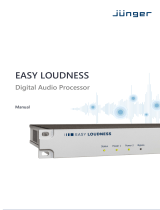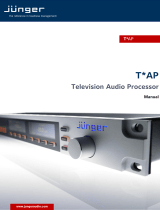
9904-UDX-OM (V1.0J) 9904-UDX-4K PRODUCT MANUAL 1-9
Introduction 9904-UDX-4K Functional Description
SDR <> HDR Conversion
Options +HDR-ITM-4K (and non-4k option +HDR-ITM) provide conversion from
Standard Dynamic Range (SDR) to High Dynamic Range (HDR) using
Technicolor
®
Intelligent Tone Management™ (ITM)
1
. ITM, when enabled, is
applied in real-time and optimizes the processed output for use HDR displays.
The SDR-to-HDR process, when used with compatible SDR sources,
typically results in enhanced luminance range, grain, and detail while
preserving the original colors/color balance in the content. De-noising and
de-banding functions provide “clean-up” of artifacts that can appear in
upconversions. Output modes include Hybrid Log Gamma (HLG) functions,
S-Gamma (SLOG3), and Perceptual Quantizer (PQ) functions.
Basically, user interface to this function is based around three modes:
Preset Mode (Basic) – This mode provides a one-button enable where HDR
conversion parameters a re optimized for typical cases, as determined by trials
observed and analyzed by experts to arrive at a best-case data set. This mode
provides simplified controls that allow “tweaking” various aspects (such as
brightness, contrast, and saturation) to obtain tailored optimized results. The
Preset Mode mode offers to the user a possibility to quickly switch between
predefined tunings, basically balancing between brightness and contrast.
Bright Spot Auto processing automatically reduces or monitors large image
areas of potential glare while not impacting small details (highlights or
“sparkles”). All underlying functions are applied on an image basis and
flexibly and automatically adapt on every image.
Manual HMS Mode – This mode exposes all available parametric controls used
in the ITM SDR-to-HDR process. The initial settings are based on data set
conclusions and provide a baseline for very detailed adjustments with a high
degree of granularity and control. This is the most flexible mode, enabling the
manual adjustment/tuning of the SDR-HDR conversion taking into full
account the picture or scene characteristics.
Auto Mode – This mode is designed to provide SDR-HDR conversion of the
video with minimal user interaction. This mode is based on machine learning
using a database of thousands of video images, wherein each were graded and
tweaked by experts arriving at base settings derived from this research and
trials. Where useful, various controls are exposed allowing further fine-tuning
of aspects temporal filtering. The Auto mode also exposes some controls
found in the Manual HMS Mode.
The SL-HDR functionality provides a single layer encoding which allows an
SDR stream for distribution, with HDR metadata that, when decoded by
compatible downstream monitors/devices, provides conversion to HDR.
1. Intelligent Tone Management™ is a trademark of Technicolor. ITM is used in this product under
license from Technicolor.

























